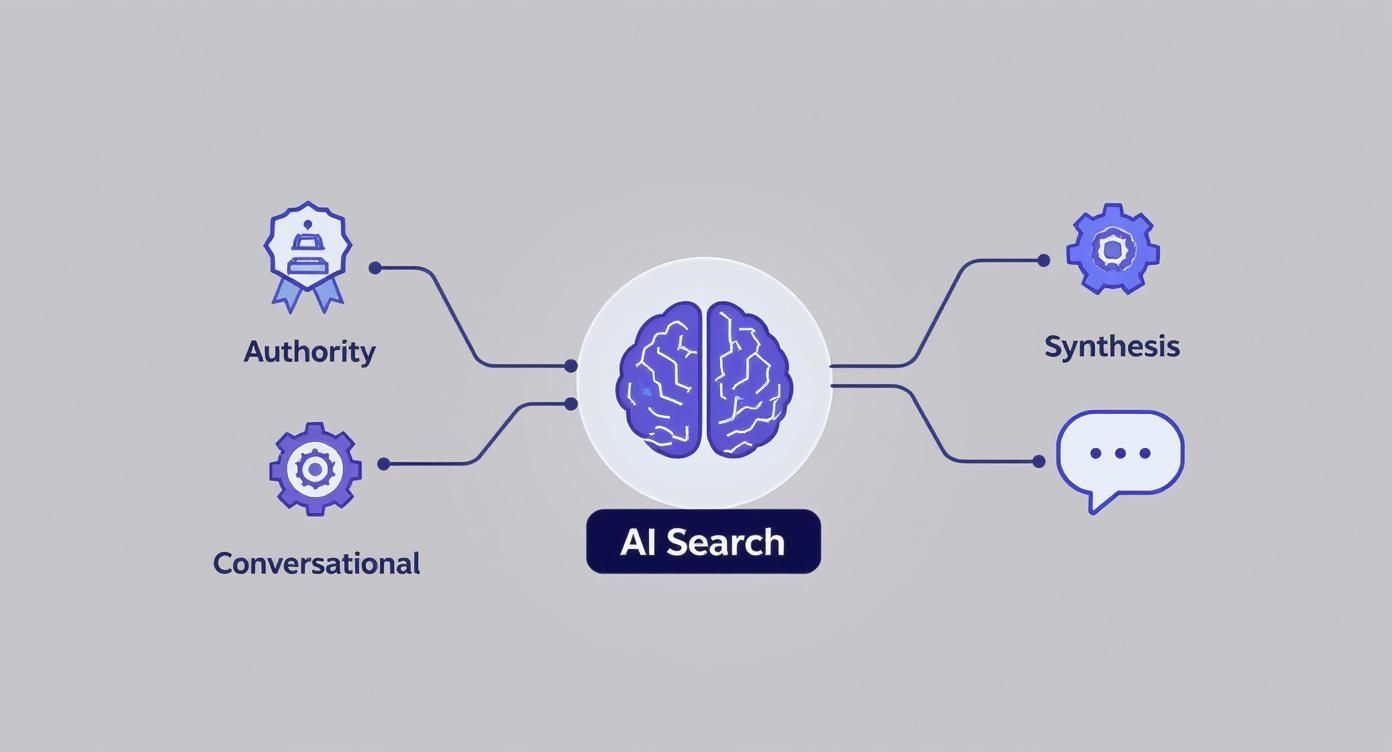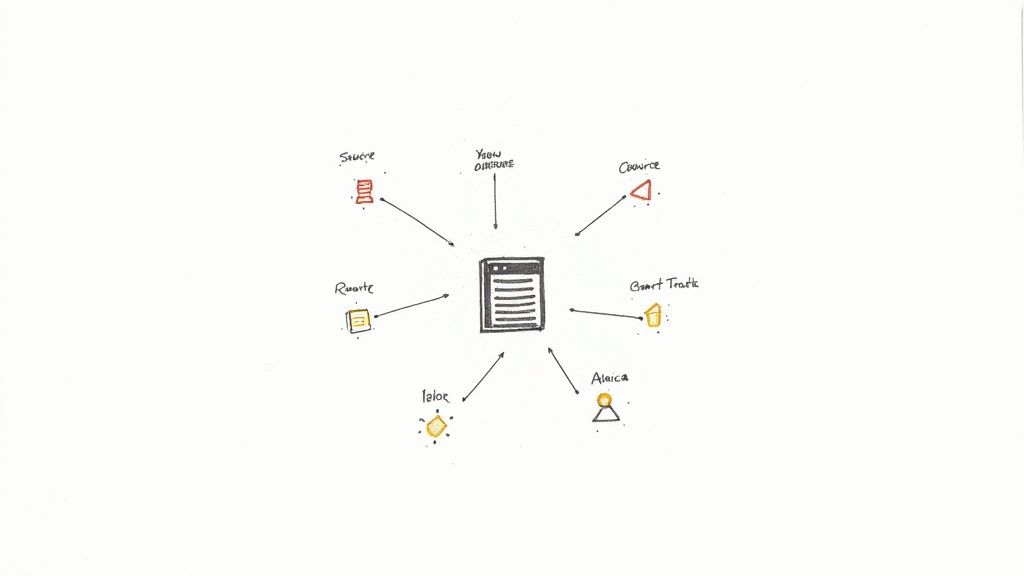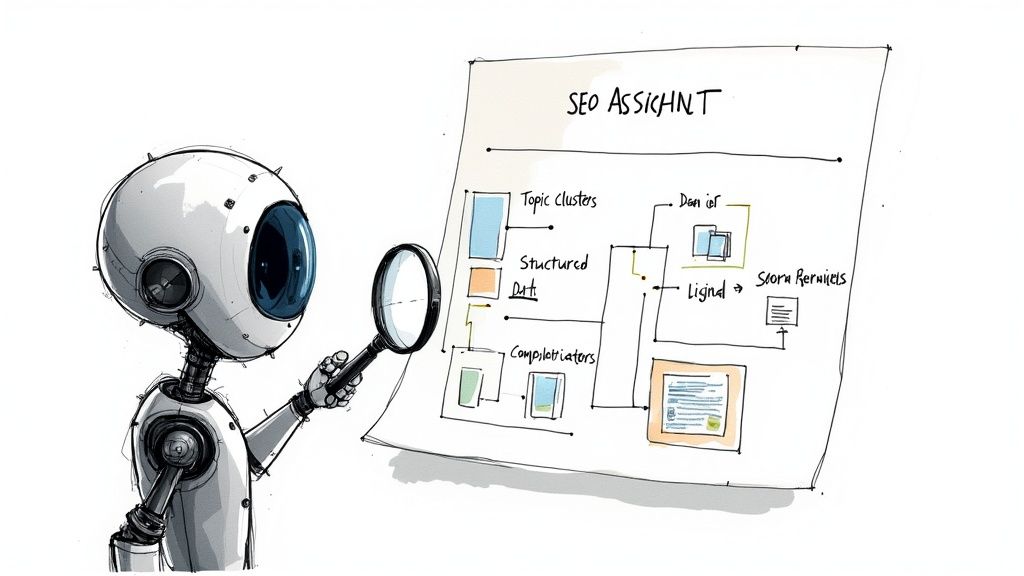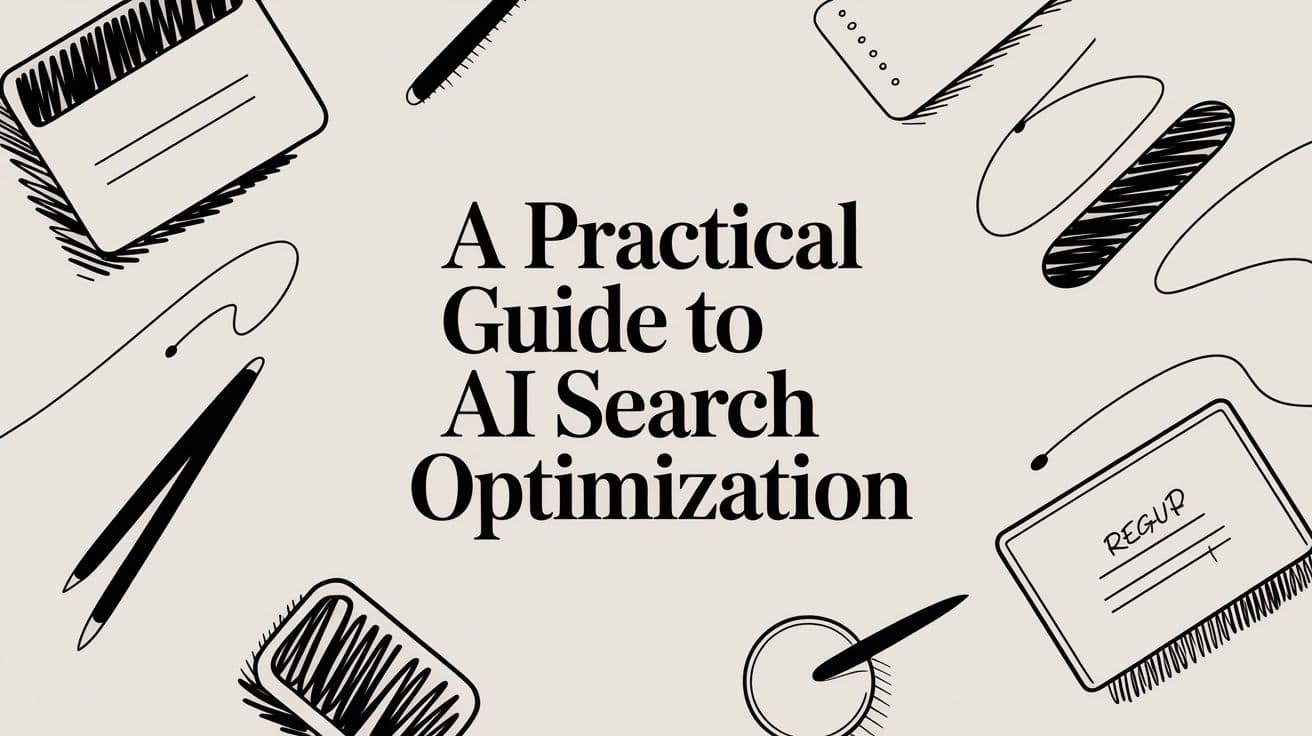If you're still fighting for the #1 spot on Google's list of blue links, you're playing yesterday's game. AI search optimization isn't just a new chapter in SEO; it's a completely different book. The goal has shifted from ranking to becoming the primary, citable source for AI engines.
Why Your Old SEO Strategy Is Broken
How people find information is changing. Instead of sifting through links, users now get direct, synthesized answers from AI models like Google's Search Generative Experience (SGE) and Perplexity.
This is a fundamental shift from search to synthesis.
AI doesn't just rank your page; it audits it. It scrutinizes your content for trustworthiness and factual accuracy before it even considers using your information. If your content isn't structured for machine readability, it's effectively invisible. Keyword stuffing and chasing backlinks won't save you.
Authority Is the New Metric
Your strategy must adapt. Authority isn't just about your domain rating anymore; it's about making your content indispensable to the AI.
This means you need to:
- Be Citable: Structure content with clear, declarative statements. Think in quotable facts, not fluffy prose.
- Prove Trustworthiness: AI models prioritize reliable sources. This makes robust data, clear sourcing, and verifiable expertise non-negotiable.
- Answer, Don't Just Rank: The new SERP is an answer, not a list. Your content must directly address user questions in a format an AI can easily digest.
This concept map shows the core pillars of AI search: authority, synthesis, and conversational queries.

The key takeaway is that these elements are interconnected. Building genuine authority makes your content a prime candidate for synthesis, especially as more people use conversational search.
The Market Shift You Can't Afford to Ignore
This isn't a future trend; it's happening now. According to one 2024 analysis, while Google still dominates search, AI-native tools like ChatGPT are growing rapidly.
This signals a massive change in user behavior. Some experts predict that by 2028, traffic from AI-generated search could surpass traditional organic referrals for many businesses.
The real challenge isn't tweaking your existing SEO practices. It’s about rethinking how you create and structure information for a world where machines are the new gatekeepers.
This requires a new approach that blends technical SEO with a relentless focus on content quality and structure. It means leaving old habits behind.
How AI Search Optimization Changes Everything
The shift from traditional SEO to AI search optimization is a change in core philosophy. Old metrics are being replaced by a new set of priorities focused on authority, clarity, and machine-readability.
Here’s how the game has changed:
| Attribute | Traditional SEO Focus | AI Search Optimization Focus |
|---|---|---|
| Primary Goal | Rank #1 on a SERP | Become a cited source in AI answers |
| Key Metric | Keyword rankings, organic traffic | Citation frequency, visibility score |
| Content Strategy | Target keywords, build backlinks | Answer specific questions directly |
| Content Structure | Long-form articles, keyword density | Factual, declarative statements |
| Authority Signal | Domain rating, backlink profile | Verifiable data, expert sourcing |
| User Interaction | User clicks a link to visit a site | User gets an instant synthesized answer |
The new rules reward being the most reliable and direct source, not just the page with the most links. For a deeper look at these differences, check out this guide on AI SEO vs. traditional SEO.
Build Authority That AI Can Understand
AI models don’t just rank your content; they audit it. Your goal is to become an indispensable, citable source for the machine. This isn't about gaming the system. It's about making your expertise so clear and well-structured that you become the lowest-risk source for the AI to cite.
Authority in AI search is earned through clarity and structure.
Translate E-E-A-T for Machines
Experience, Expertise, Authoritativeness, and Trustworthiness (E-E-A-T) are still the foundation. But for ai search optimization, you must translate those concepts into a language machines can parse.
An AI can’t infer your team’s decades of experience from a well-written story.
You have to be explicit.
Instead of just mentioning an expert, connect them to the content with structured data. Instead of stating facts, present them in formats that are easy to parse, quote, and verify.
Make Your Facts Machine-Readable with Schema
Schema markup is a vocabulary that gives search engines and AI models explicit context about your content. It’s like labeling your information so there’s zero room for misinterpretation. You are spoon-feeding the AI the exact facts you want it to know.
You can use specific Schema types to define crucial authority signals:
Author: Link content to a specific person’s profile, complete with their credentials and social proof. This makes expertise tangible.Organization: Establish your brand as a legitimate entity with details like your official name and logo.ClaimReview: Debunk misinformation or validate a claim with evidence, positioning you as a source of truth.
The library of schema types on Schema.org is vast, showing just how granular you can get.

This extensive vocabulary allows you to label nearly any piece of information on your site, turning ambiguous text into structured, reliable data points.
Structure Content with Declarative Statements
AI models extract and synthesize information. To make their job easier, structure your content with clean, declarative sentences that state a fact directly. Avoid long paragraphs loaded with multiple ideas.
The goal is to create "snippable" content—phrases and sentences that make perfect sense when pulled out of context and placed into an AI-generated answer.
This means favoring directness over literary flair.
Weak Example (Hard to Parse): "Our advanced software, which has been developed over many years by a team of dedicated experts, can help businesses by offering them a suite of tools designed to improve their operational workflows in a number of key areas."
Strong Example (Easy to Cite): "Our software includes tools for project management, inventory tracking, and customer relationship management. It reduces operational costs by an average of 15%."
The second example gives the AI specific, quotable facts.
Build Topical Depth with Internal Links
A smart internal linking strategy does more than pass link equity. For AI algorithms, it creates a map of your expertise. When you comprehensively link between related articles, you signal a deep, well-organized knowledge base on a specific topic.
This helps an AI understand that you're an authority on an entire subject, which is a critical part of ai search optimization.
Mini Case Study: B2B SaaS Resource Hub A B2B SaaS company in logistics struggled to get cited in AI answers. Their blog had good content, but it was siloed and lacked hard data.
Here’s the framework they used:
- Map a Topic Cluster: They identified their core service ("warehouse optimization") and mapped out related sub-topics like "inventory slotting" and "labor management systems."
- Inject Verifiable Data: Each article was updated with specific statistics, data from industry reports (with citations), and quotes from their in-house experts.
- Implement a Hub-and-Spoke Linking Model: Their main "warehouse optimization" guide became the hub, linking out to every sub-topic. Crucially, each "spoke" article linked back to the hub and to other relevant spokes.
Within three months, their brand saw a 150% increase in citations within AI-generated answers for their target queries. They built a web of evidence that was too strong to ignore.
Optimize Content for Conversational Queries

People don't type keywords into AI search. They have conversations. They ask long, specific questions in plain English and expect a direct, synthesized answer.
Your goal is no longer to rank for a keyword, but to be the source that most efficiently answers a question.
If your content is a wall of text that forces an AI to dig for an answer, it’ll move on. The content that wins is structured for immediate clarity.
Find the Questions People Actually Ask
You can't provide the answer if you don't know the question. Traditional keyword research tools are a starting point, but you need to find the conversational queries your audience uses.
Here's how:
- Filter for Questions: In Ahrefs or Semrush, filter your keyword lists to only show queries with words like "how," "what," "why," or "compare." This focuses you on specific problems.
- Mine "People Also Ask": Google's PAA boxes are a goldmine of the literal questions searchers are asking right now.
- Check Forums and Communities: Scour Reddit, Quora, and industry forums. The language people use there is exactly how they talk to AI assistants.
This process takes you from targeting vague terms to addressing specific, high-intent needs.
Structure Your Content Like an Answer Engine
Once you have your questions, bake the answers directly into your content's structure. Think of your headings as the questions and the following text as the concise answer.
To do this well, it helps to understand technologies like Natural Language Processing (NLP), which is how machines interpret human language.
Your H2s and H3s are no longer just section breaks; they are direct answers waiting to be extracted. An AI model can parse a well-structured HTML document far more easily than a dense block of prose.
This approach turns your content into a pre-packaged solution for an AI assistant. The easier you make its job, the more likely you are to be cited. Learn more in our guide to Answer Engine Optimization.
A Practical E-commerce Example
An e-commerce client sells high-end outdoor gear. Their old product descriptions were a boring bulleted list of technical specs.
- Weight 2.5 lbs
- Waterproof rating IPX7
- Ripstop nylon fabric
This tells a user what the product is but fails to answer conversational questions. They were invisible in AI-powered shopping results.
We revamped their product pages into a question-and-answer format using H3s:
- How much does this tent weigh? It weighs just 2.5 pounds, making it perfect for multi-day backpacking trips where every ounce counts.
- Is this tent fully waterproof? Yes, it has an IPX7 waterproof rating, meaning it can handle heavy, sustained rain without leaks.
- How durable is the material? The tent is made from tough ripstop nylon fabric, which is highly resistant to tearing and abrasion.
The shift was simple, but the impact was huge. Within two months, they saw a 40% jump in visibility in AI-powered shopping results because they became the most efficient source of answers. They didn't just list features; they solved problems.
That's the core of modern AI search optimization.
Using AI Tools in Your SEO Workflow

To get your content recognized by AI, you need to bring AI into your own process. This isn’t about automation taking over your strategy. It's about using AI as a smart assistant to do the heavy lifting—the tedious analysis and data crunching—so you can focus on creating authoritative, useful content.
This isn't a niche tactic. By 2025, it's expected that 86% of SEO professionals will use AI tools. A 2024 survey showed that 75% already use AI to speed up keyword research and content optimization. The trend is clear: we're moving toward smarter, data-led strategies.
Analyze Your Competition on AI SERPs
Looking at the top 10 blue links is outdated. Your new competitors are the websites getting cited inside AI-generated answers, and you can't analyze that landscape with old tools.
You need tools built for this new reality. They show you exactly which domains are being sourced for your most important queries, giving you a clear roadmap for your ai search optimization efforts. Instead of guessing, you can see the content structures, data points, and schema types that models like ChatGPT and Perplexity reward.
Build and Deepen Topic Clusters
Proving topical authority is critical. AI tools can accelerate this by helping you map out complete topic clusters that cover a subject from every angle.
Use an AI tool to generate every related sub-topic, user question, and semantic connection to your main subject. This methodical approach ensures you leave no content gaps, signaling to AI models that your website is the definitive source of knowledge on that topic.
The goal is to build a web of interconnected content so dense and valuable that the AI has no choice but to see your site as the primary authority.
To make this work, you need to get good at prompt engineering. Learning to write precise prompts is a massive advantage. This guide on What Is Prompt Engineering: A Data-Driven Guide is a great place to start.
Practical AI Tool Applications for SEO
Let's break down how AI changes everyday SEO tasks from manual processes to efficient, AI-assisted workflows.
| SEO Task | Traditional Method | AI-Assisted Method | Recommended Tool Type |
|---|---|---|---|
| Keyword Research | Manually brainstorming seeds, using keyword tools for volume/difficulty. | Generating hundreds of long-tail questions and user intent clusters in minutes. | LLMs (ChatGPT, Claude), Specialized SEO AI Tools |
| Content Briefing | Manually analyzing top SERPs for headings, questions, and entities. | Instantly analyzing SERPs, identifying key entities, and structuring a comprehensive outline. | Content Optimization Platforms (SurferSEO, Clearscope) |
| Competitive Analysis | Reviewing a competitor's top pages one by one for gaps. | Feeding a URL to an AI and asking it to pinpoint unsourced claims and unanswered questions. | LLMs (ChatGPT, Claude), Custom AI Agents |
| On-Page Optimization | Manually checking for keyword usage, meta tags, and internal links. | Automatically identifying optimization opportunities based on NLP analysis of top-ranking content. | Content Optimization Platforms |
This shows how much grunt work can be offloaded, letting you focus on strategy and quality.
Use AI as Your Strategic Assistant
The best way to use AI is as a tireless analyst, not a content writer. You can feed it your competitor's top content and ask it to perform surgical tasks that would take a person hours.
Mini Case Study: Outsmarting a Competitor A marketing agency took on a client in the competitive CRM market. They identified the top-cited competitor for "best CRM for small business." Then, they fed that competitor's article to an AI with a specific prompt.
Prompt Used: "Analyze the attached article. Identify all factual claims made without a source. List all user questions that remain unanswered by the end of the text. Suggest three data points or expert quotes that would strengthen the content's authority."
The AI's output was a surgical plan for creating a superior piece of content. They weren't just writing another generic blog post; they were methodically filling every gap their competitor left open. This strategic use of ai search optimization is what separates winning strategies from the noise. For more ideas, check out this list of the best AI SEO tools on the market.
How to Measure Success When Clicks Don't Matter
The old SEO dashboard is broken. We’ve spent years chasing rank positions and organic clicks, but those metrics are becoming relics. When an AI gives a direct answer, the user has zero reason to click your link—even if you're the source.
Success with ai search optimization is no longer about driving traffic. It's about earning influence. It's time to stop asking, "How many people visited my site?" and start asking, "How often is my brand the source of truth?"
From Clicks to Citations
The single most important metric is citation frequency. This is a direct count of how often an AI model names your brand as a source in its answers. Each citation is a vote of confidence that your content is authoritative.
Trying to track this manually is impossible. You need a dedicated platform like AI SEO Tracker to monitor your visibility across different AI models and for the specific queries your customers are asking. This gives you a clear picture of where your content is being used and where your competitors are winning.
When your brand becomes the citation, you win the SERP. Your authority is established before a user ever has to click a link.
The Rise of Branded and Direct Traffic
As users see your brand name cited repeatedly as the expert, their habits change. They stop searching for "best project management software" and start searching for your brand name. Or they go straight to your website.
Two powerful indicators of successful ai search optimization are:
- An increase in branded search volume: More people are looking for you by name because AI told them you're the expert.
- A rise in direct traffic: Users trust you enough to bypass search and navigate straight to your domain.
These are not vanity metrics. They are hard evidence that you're building a brand with real authority.
Proving the ROI of AI Search Optimization
You have to connect these new metrics to revenue. The key is to track your citation rate for high-intent, bottom-of-the-funnel queries—the questions people ask right before they buy.
Mini Case Study: A B2B Finance Platform A fintech company wanted to be the go-to source for "how to choose an invoicing software."
- Months 1-3: They established a baseline. Their citation share was a meager 5%.
- Months 4-6: After optimizing their content to directly answer questions about features, integrations, and pricing, their citation share jumped to 30%.
- The Result: Over that same period, they saw a 22% increase in demo requests that came from direct and branded traffic.
They drew a straight line from their influence in AI answers to a tangible business outcome, proving the ROI of their ai search optimization efforts. To build your own business case, see how our revenue calculator can estimate potential returns.
Your AI Search Optimization Action Plan
The move to an AI-first search world is here. Instead of getting lost in hypotheticals, here is your game plan for taking smart, deliberate action.
Will AI Search Optimization Replace Traditional SEO?
No, it builds on it. AI search optimization requires the foundation that traditional SEO creates. Technical site health, a logical site structure, and high-quality backlinks are still the cost of entry. These core elements signal to search engines that your website is a credible resource, making it a trustworthy candidate for AI models to even consider.
What Is the Single Most Important Factor for AI Answers?
Becoming a verifiable, authoritative source. Reliability is the new ranking factor. AI models are designed to deliver accurate, low-risk information by citing content from sources they've determined are factually correct.
This means you need to focus on:
- Data-Driven Content: Back up every claim. Use specific numbers, statistics, and sourced data.
- Clear Expert Signals: Use author schema and quotes from credible experts to link your content to real people with authority.
- Structured Facts: Implement schema markup that turns your key information into machine-readable facts.
How Can Small Businesses Compete Against Big Brands?
Go deep, not wide. Dominate a specific niche. Don't try to be an authority on "marketing." Instead, become the undisputed expert on "AI-powered email marketing for SaaS startups."
Big brands often keep their content general. That's your opening. You can create incredibly detailed content that answers very specific questions better than anyone else.
AI algorithms reward depth of expertise. A focused strategy lets a smaller business build true authority much faster than a larger competitor.
This makes you the most relevant source for a specific set of conversational questions, which in turn makes you the obvious choice for an AI citation.
How Often Should I Update Content for AI Search?
Content freshness signals relevance and reliability. An AI is less likely to cite a source with data from three years ago. For your most important content, review and update it at least quarterly.
This doesn't always require a complete rewrite. It could be as simple as updating statistics, adding new examples, or refreshing expert quotes. For fast-moving fields like tech or finance, monthly check-ins may be necessary. The goal is to signal that your content is a living, actively maintained resource.
Ready to stop guessing and start measuring your influence? See exactly where your brand appears in AI answers from ChatGPT, Gemini, and more. With AI SEO Tracker, you can pinpoint citation gaps, analyze your competitors, and get a clear action plan to become the go-to source in your industry.

